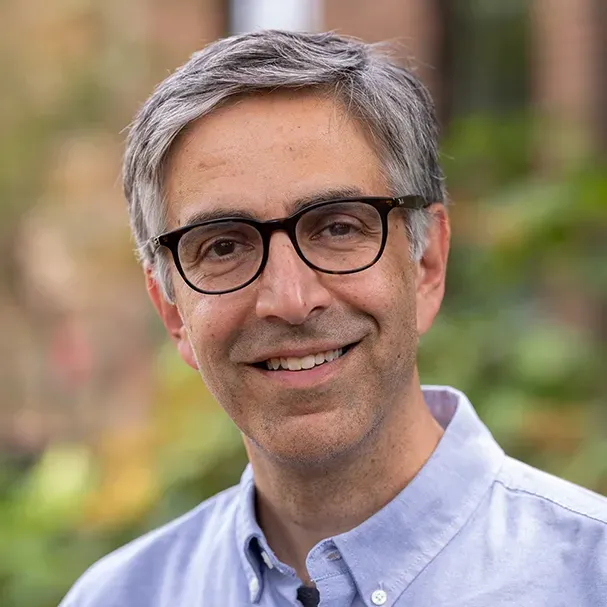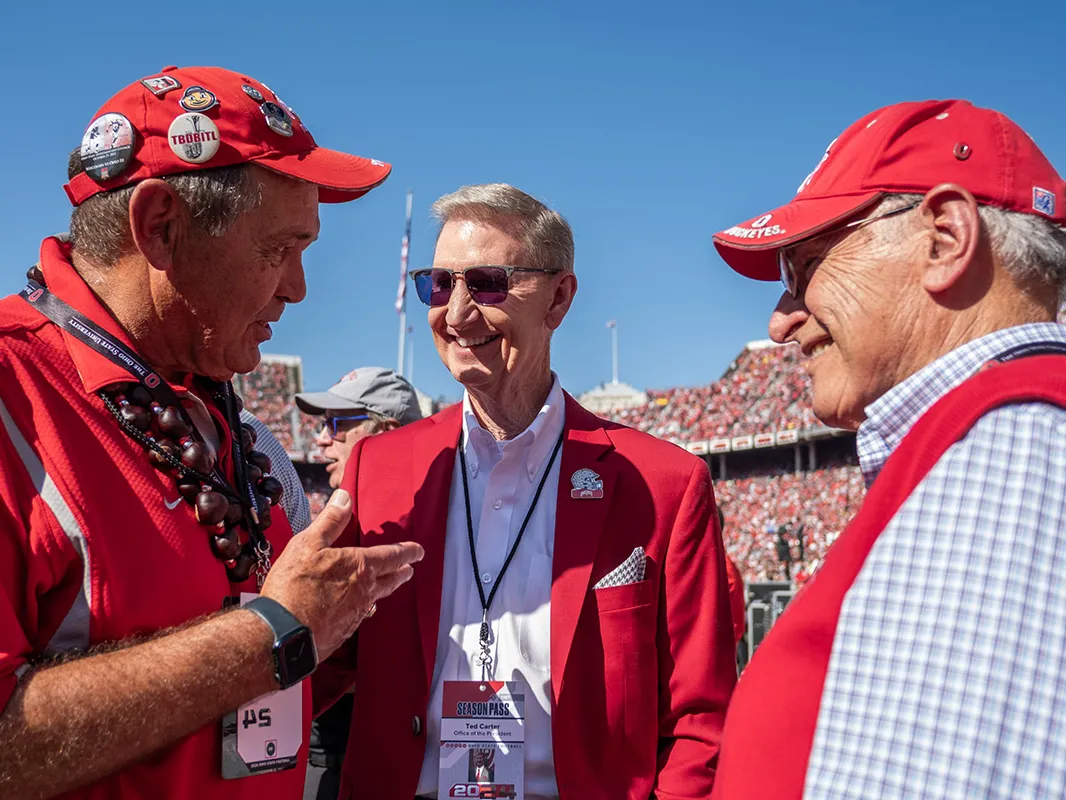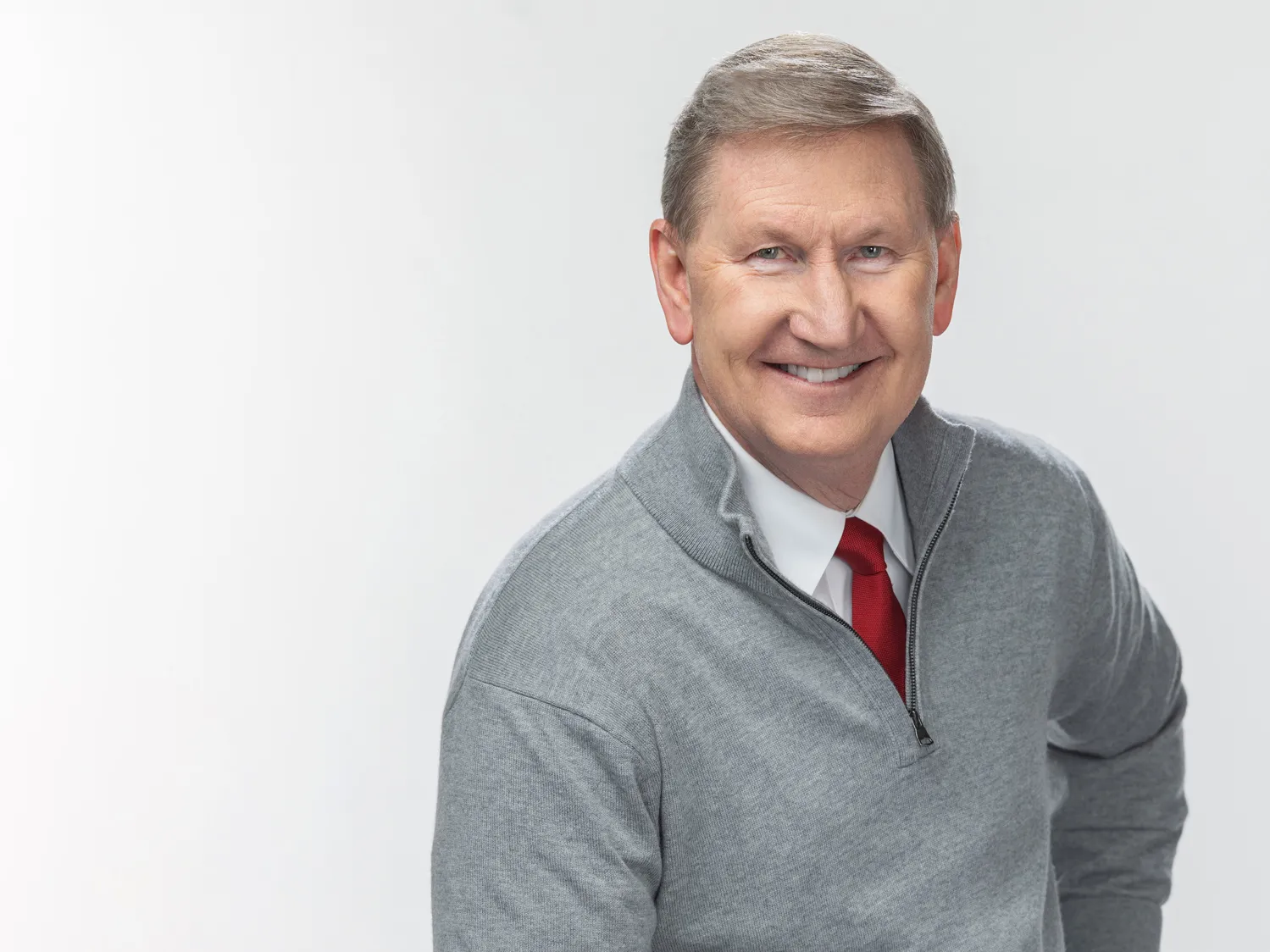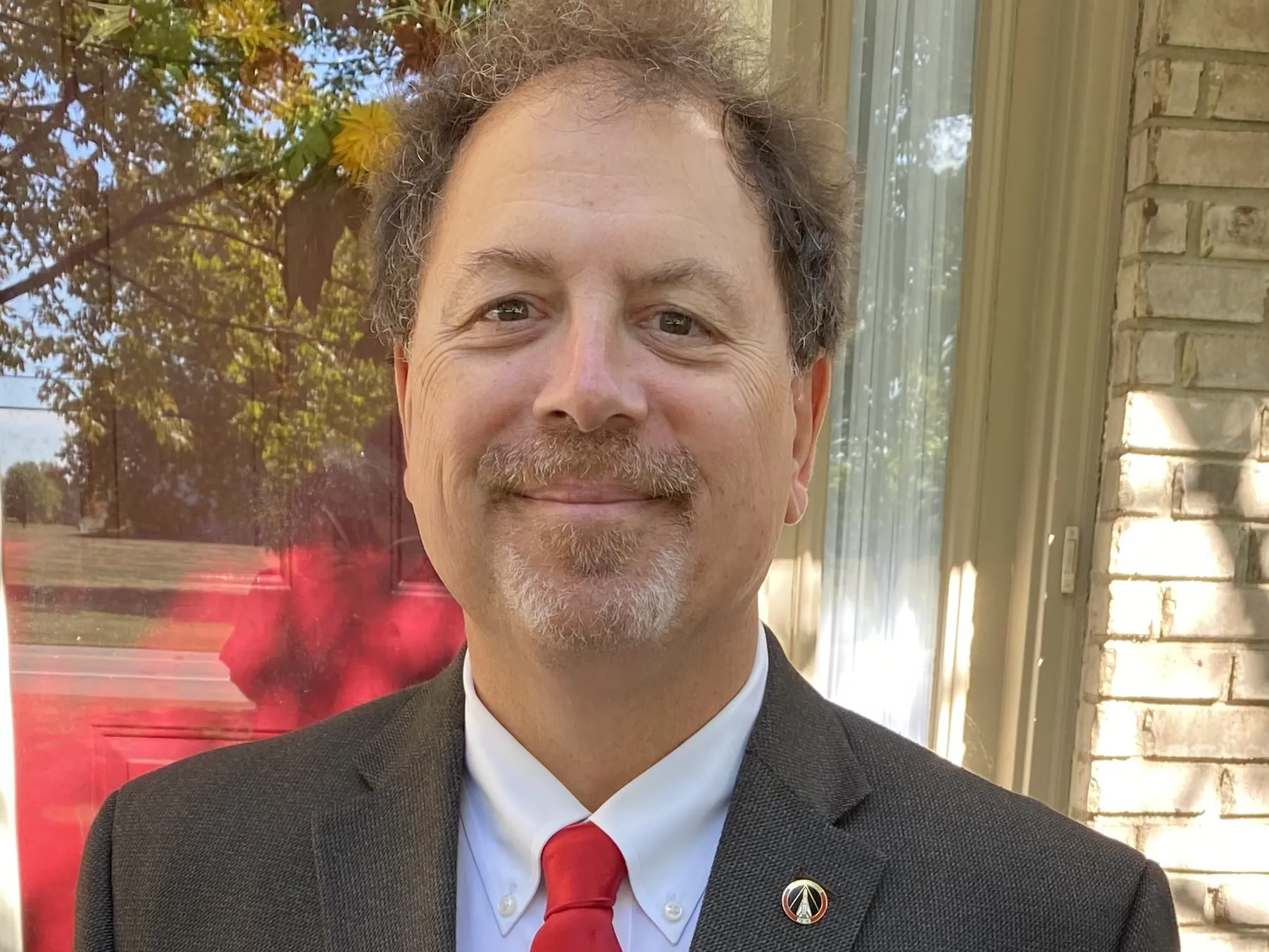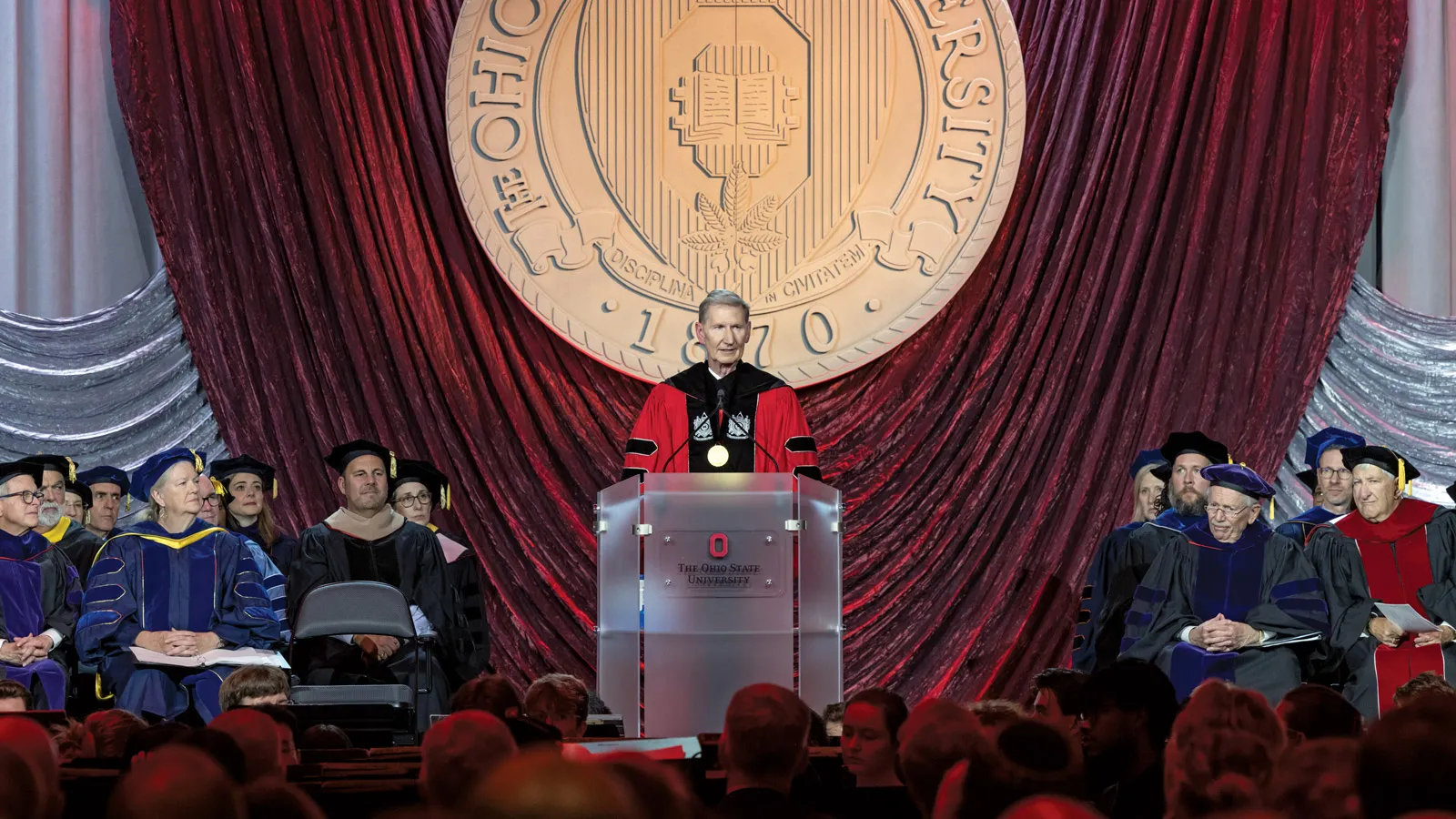
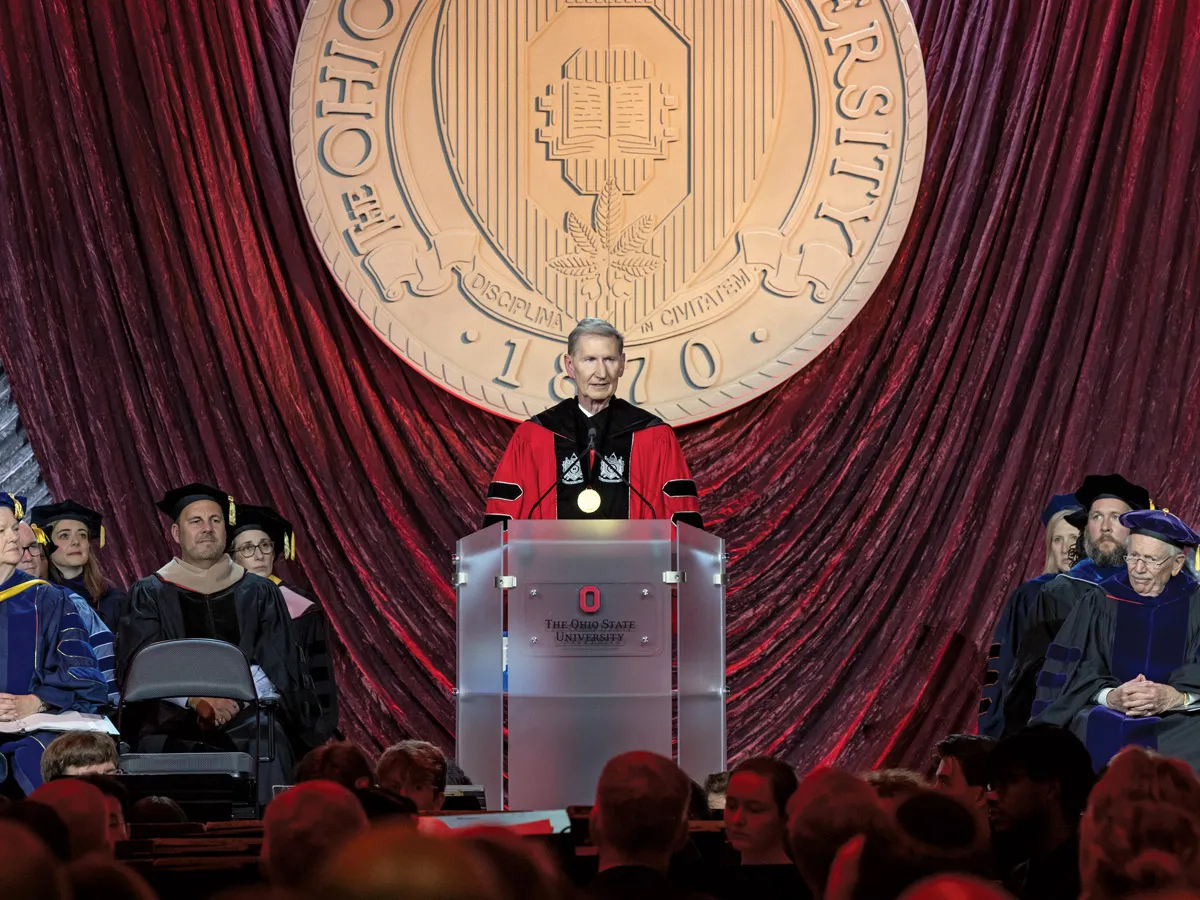
Future forward
For his investiture as the university’s 17th president, Walter “Ted” Carter Jr. shares his vision for turning Ohio State into a higher education exemplar for the nation.
A history lesson awaits the Ohio State community. As university officials, statewide leaders and other dignitaries gather to celebrate Walter “Ted” Carter Jr.’s investiture as Ohio State’s 17th president, they’re greeted by a banner quoting one of his predecessors, George Washington Rightmire. The name likely doesn’t ring a bell for most folks at the Greater Columbus Convention Center. But Carter and his team have a reason for giving Rightmire, Ohio State’s sixth president, such prominence, putting his portrait on display alongside images of more familiar Buckeyes: renowned scientists, record-setting athletes, a beloved anthropomorphic nut.
Carter spent much of his first year in office listening and learning. And as he met with hundreds of Ohio State stakeholders on campus and beyond, he kept encountering two characteristics: a great respect for tradition and history, and a commitment to evolving and getting better. That works for Carter. He embraced change as he began to formulate a long-term vision for the university. But he also drew inspiration from the past—in particular, the words and wisdom of Rightmire.
On this Friday afternoon in early November, Carter stands at the center of a ballroom stage, surrounded by university trustees, members of his cabinet and Gov. Mike DeWine, all wearing mortarboards and ceremonial robes. Carter’s investiture not only marks his official installation as Ohio State’s president, though he’s technically been on the job since Jan. 1; it’s also an opportunity for him to introduce his strategic framework for the university—Education for Citizenship 2035, which takes its name from the university motto, coined in 1938 during Rightmire’s presidency and inscribed in Latin on the official Ohio State seal. A big seal hangs behind Carter.
“Can you imagine what it must have been like to be running a higher ed institution during the Great Depression?” Carter asks the crowd. “Not knowing that Pearl Harbor was around the corner, not knowing that World War II would change the world forever, not knowing what the post-war GI Bill would do for Ohio State and this country. But he picked those three words because it was mission-oriented, and it was at a critical intersection for higher ed.”
In his own words
Watch a video of President Ted Carter’s investiture ceremony, in which he lays out his vision for Ohio State.
Today, Ohio State and its peers face a new inflection point, Carter says. A deeply divided American public is losing faith in colleges and universities. In June, a Gallup poll revealed that just 36 percent of U.S. adults had high confidence in higher education, a 20 percentage-point drop from 2015. As Rightmire did during his 12-year tenure in the 1920s and ’30s, today’s collegiate leaders must find a new path forward, reimagining their purposes and proving that higher education still makes a valuable contribution. “That’s why our team decided that ‘education for citizenship’ is the right mission for us right now,” Carter says.
Despite the challenging environment, Ohio State is poised to meet the moment, Carter says. While peer institutions struggle to win over the public, 72 percent of Ohioans surveyed say their state is better off because of its flagship university, according to a recent Association of American Universities survey. While peers struggle to attract students amid demographic shifts and rising tuition, Ohio State welcomed in August the largest first-year class in its history.
Yet Carter warns against complacency. “We could just keep doing what we’re doing, but what made us successful in the past, given these incredible headwinds, is not what will make us successful in the future,” he says.
The moment requires bold action—and Carter’s 10-year strategic plan is setting a framework for accomplishing big goals across six themes: academics, research and creative expression, health care, talent and culture, operations, and collegiate athletics. Over the coming months, he wants the university community to help him fill in that framework with specific ideas and initiatives around such timely and challenging issues as reducing student debt, improving accessibility, expanding medical care, strengthening alumni connections and advancing artificial intelligence, among other things.
“The future of higher education is and will be here at Ohio State University,” Carter says. “We will be the model for the nation.”
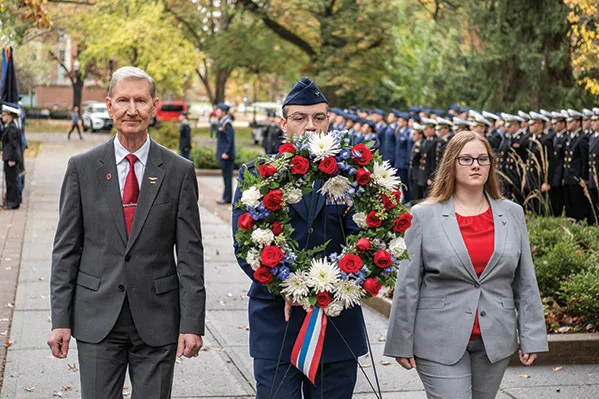
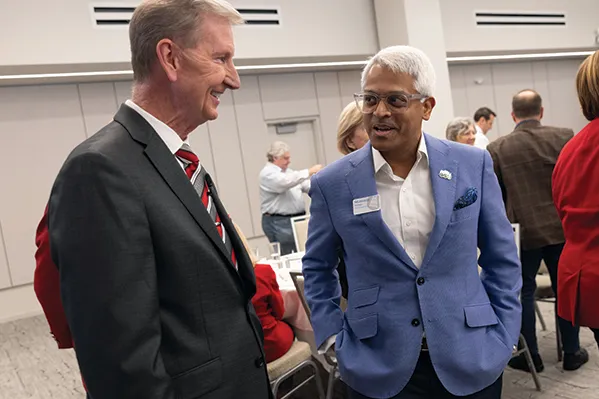
Three weeks earlier, Carter delivers another speech, though this time without any ceremonial garb. He addresses the City Club of Cleveland, the vaunted public forum that has hosted U.S. presidents, civil rights heroes, business titans, U.S. secretaries of state and other world-renowned figures over the past century. “It’s very humbling to be onstage in front of all of you today, knowing who’s been here before me,” Carter says.
Carter excels in these types of settings. A skilled communicator, he talks for nearly an hour with no notes, citing facts and figures from memory and weaving in telling anecdotes and humorous asides. He mentions Ohio State football coach Ryan Day likes to remind him that there are 16 million Buckeyes fans. “When we unfortunately do lose a game, I hear from all 16 million,” Carter says, drawing a big laugh from the crowd. Six days earlier, the Buckeyes suffered a painful one-point loss to Oregon. “Not to worry,” Carter calmly interjects. “We’re going to correct that.”
That cool, unflappable demeanor is another Carter trademark, perhaps not surprising for a former U.S. Navy pilot who’s logged more than 6,300 flight hours, flown 125 combat missions and set a national record of more than 2,000 landings on aircraft carriers. He’s diplomatic, quick on his feet, comfortable answering off-the-cuff questions from reporters or everyday folks. He knows how to work a room, graciously greeting a diverse swath of alumni and Northeast Ohio leaders at this luncheon in downtown Cleveland. And while he’s an excellent public speaker, he’s also an attentive listener—a quality that has been perhaps even more important during his first year at Ohio State.
Carter didn’t rush into any changes when he arrived in Columbus. Instead, he’s been a deliberate and meticulous student, learning bit by bit about the unique qualities of the immensely complicated institution he now leads. He participated in workshops with about 1,000 stakeholders who know and love the university. He visited all 15 colleges and the four regional campuses, as well as Ohio State University Agricultural Technical Institute in Wooster. He’s traveled all over the state, hitting about half of Ohio’s 88 counties.
During the November investiture ceremony, Tracey Boggs ’07, chair of the University Staff Advisory Committee (USAC), praised Carter for this outreach. “Over the past 10 months, President Carter has taken the time to observe and listen to our community,” said Boggs, whose organization serves as the bridge between staff and university leadership. “He has actively engaged with USAC, demonstrating his commitment to understanding the employee experience. I am impressed by President Carter’s ability to lead through human connection and inspired by his belief that we can handle hard things.”
University Senate Secretary Jared Gardner came away deeply impressed with Carter after attending one of his listening sessions. As a professor for three decades—25 years at Ohio State and five at a small Iowa liberal arts college—Gardner has participated in many of these types of programs. Though well intentioned, they often can come off as ceremonial. Carter’s session, however, was different. “I felt he’s really there listening,” recalls Gardner, the Joseph V. Denney Designated Professor of English. “He wants to hear. He’s making adjustments and tweaks to some of his own assumptions based on what he’s hearing from different constituent groups.”
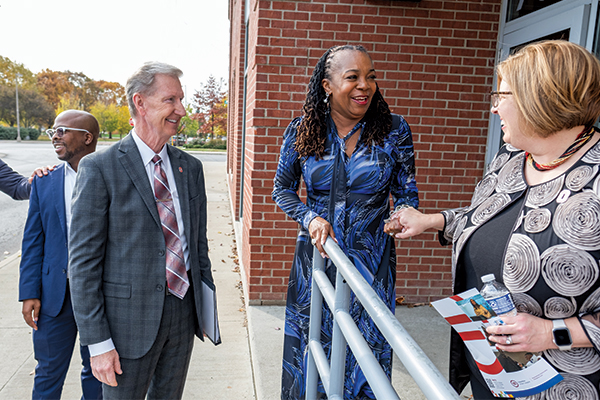
Indeed, Carter has worked collaboratively with the entire Buckeye community: faculty, staff, students, alumni, donors, legislators, business leaders—pretty much anyone willing to spend a few hours with him, he says. That includes those on the opposite sides of the Israeli-Palestinian divide. During the first week of class at Ohio State in January, Carter met with representatives from both Students for Justice in Palestine and Ohio State University Hillel; he knew the Gaza conflict would pose a challenge during his first few months on the job, and he wanted to face it head-on. “I tried to say as little as possible, just to let them talk to me,” he says. In 2024, Ohio State experienced less turmoil on its campus than other universities did, though police arrested 36 protesters in April, 16 of whom were Ohio State students, according to WOSU. University leaders made the difficult decision to stop protesters from setting up encampments, which are a safety issue and a violation of Ohio State’s space rules. That action differed from other universities, which allowed encampments to grow and endured significant unrest in the aftermath.
Carter is proud that Ohio State launched a new civil discourse initiative—called “Listen. Learn. Discuss.”—in response to the campus unrest. The program includes workshops, classroom experiences and other resources to help participants navigate difficult conversations more effectively. “It’s a discussion that I think all universities should be having about, ‘It’s OK to disagree, but let’s try to figure out how to disagree better.’”
While Carter avoided making major university changes during his first year in office, he did take decisive action in his personal life. Over the past few months, he’s lost some 40 pounds—an impressive feat for a 65-year-old man (or anyone, for that matter). “I changed my diet,” he says. “I changed my sleeping schedule. I changed my alcohol intake.” He’s now back to his fighter jet pilot weight, healthier than he has been in years as he enters a new leadership phase at Ohio State.
After months of listening, Carter has now moved into “action mode,” as he calls it. During his investiture speech—as well as in recent interviews and other public remarks—he’s begun to outline his vision for the university. He and his leadership team haven’t formed many specific initiatives yet, but that will come soon. Here are some of Carter’s initial broad ideas and priorities.
Artificial intelligence: Carter identifies AI as one of his most pressing research and innovation goals, with the Carmenton innovation district and the Center for Software Innovation key components of that effort. “I want us to be the center, the tech hub model for the nation for artificial intelligence,” he says. “And much of it will be tied to the type of research and development that we’re going to be able to do out in Carmenton.”
Mentors and internships: Carter wants to better connect Ohio State students to the university’s more than 600,000 living alumni through a more formalized mentorship program. “Our students should know before they graduate that there’s an amazing network that’s going to help them be successful,” he says. In addition, Carter envisions a more robust internship program. “Imagine a scenario where every undergraduate student had a meaningful internship opportunity,” he says.
Athletics: As Ohio State moves toward a shared revenue model with collegiate athletes, Carter remains committed to maintaining all 36 of the university’s Division I sports. “We’re going to have to build some financial models that will allow for that and still do the shared revenue piece,” he says, pointing to additional concerts, outdoor hockey games and other Ohio Stadium ideas as possible new revenue sources. “Is it going to look different? There’s no doubt, because nobody else is doing it.”
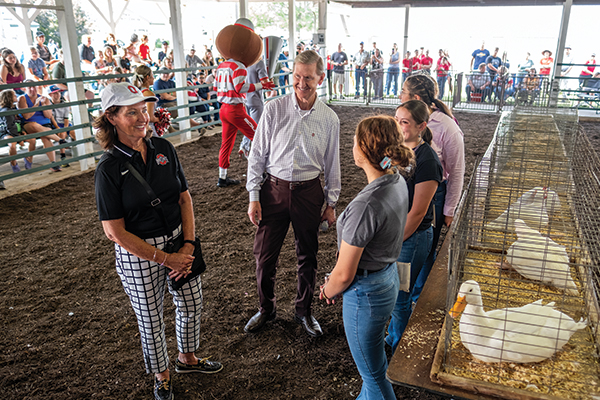
Access and affordability: While Columbus campus admissions have become more selective, Carter wants to maintain a strong pathway for every Ohio student and adult learner to come to Ohio State. He says the university will continue to invest in its regional campuses and strengthen relationships with partners, such as Columbus State Community College and Cuyahoga Community College in Cleveland.
Ohio State is more affordable than many institutions—58 percent of undergraduates leave with no debt, 20 percentage points better than the national average, Carter says—but he believes that the university can improve in this area, perhaps by providing more support to graduate students and middle-income students.
Clinical care: The Ohio State Wexner Medical Center cares for 23 percent of the population in Central Ohio, and with a new 26-floor hospital tower set to open in 2026, the university is positioned to better serve the growing Columbus region, as well as the rest of the state, Carter says. That includes Ohio’s 32 Appalachian counties, which are in dire need of doctors, nurses, dentists and hygienists. “How will we find our way to make sure that we’re taking care of all Ohioans?” Carter asks.
Gardner, the University Senate leader, describes Carter’s investiture speech as “just what I needed at this moment”—a broad vision that embraces both the past and future, welcomes input from across the university and recognizes the challenges facing higher education, as well as Ohio State’s unique strengths. “I feel like this is one of those moments you don’t get often in a career where you feel like you have the right leader at the right time,” Gardner says. Peter Mohler, the leader of the university’s Enterprise for Research, Innovation and Knowledge, says Carter’s speech delivered an important message of inclusiveness and positivity, while also pushing for change and exploring how lessons learned over the last 150 years can be applied to the future. “It’s really setting the tone for what a land-grant university looks like for the next 100 years,” Mohler says.
In early 2025, Carter and other university leaders will dig deeper into the ideas and themes he outlined in his investiture speech. On July 1, the plan will go into action. It will feature specific initiatives and measurable performance indicators and will continue to evolve over the next decade. “We will report on it,” Carter says. “We’ll measure it.”
In other words, the job is just beginning. After talking for about an hour, Carter concludes his investiture remarks with an exhortation (and a challenge) for the Ohio State community. “Now let’s get to work,” he says.
